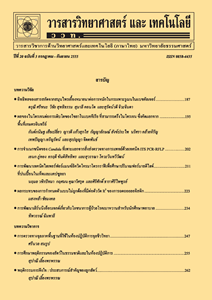การเปรียบเทียบวิธีการพยากรณ์สำหรับอนุกรมเวลาที่มีลักษณะไม่เป็นเชิงเส้นและไม่คงที่
Main Article Content
Abstract
This research studied non-linear and non-stationary time series for three forecasting methods that were Box-Jenkins method with ARIMA model, empirical mode decomposition with ARIMA model of Box-Jenkins method (EMD-ARIMA) and ensemble empirical mode decomposition with ARIMA model of Box-Jenkins method (EEMD-ARIMA). Time series data with 170 values were simulated by program R in six models consisting of second and third-order polynomial trend time series, exponential trend time series with positive and negative exponents and logistic trend time series with positive and negative exponents. The data were divided into two parts. The first part with 150 values, was used to create forecasting model and the second part with 20 values, was used for comparing efficiency of forecasting methods. Efficiency criteria were MSE and MAPE. The results showed that the Box-Jenkins method with ARIMA model was the most efficient method for forecasting exponential trend time series with positive exponent and logistic trend time series, whereas the EMD-ARIMA method was the most efficient method for exponential trend time series. In addition, the EEMD-ARIMA method was the most efficient method for forecasting polynomial, exponential trend time series with positive exponent and logistic trend time series.
Article Details
References
[2] Bao, Y., Yi, D. and Chen, J., 2012, Forecasting software reliability using Arima with ensemble empirical mode decomposition, Int. J. Model. Simul. 32: 104-110.
[3] Abadan, S. and Shabri, A., 2014, Hybrid empirical mode decomposition-ARIMA for forecasting price of rice, Appl. Math. Sci. 8: 3133-3143.
[4] Zhou, Y. and Huang, M., 2016, Lithium-ion batteries remaining useful life prediction based on a mixture of empirical mode decomposition and ARIMA model, Microelect. Reliab. 65: 265-273.
[5] Min, Y., Bin, Y., Liang-li, Z. and Xi, C., 2015, Wind Speed Forecasting Based on EEMD and ARIMA, Chinese Automation Congress, Wuhan.
[6] Polynomial, Available Source: https://en.wikipedia.org/wiki/Polynomial, June 5, 2018.
[7] Exponential Function, Available Source: https://en.wikipedia.org/wiki/Exponential_function, June 5, 2018.
[8] Logistic Function, Available Source: https://en.wikipedia.org/wiki/Logistic_function, June 5, 2018.
[9] Choopradit, B. and Chaipitak, S., 2018, Forecasting model for mango export volumes of Thailand, Naresuan Univ. J. Sci. Technol. 26(2): 74-85. (in Thai)
[10] Mantmin, M., 2006, Time Series Forecasting, Praguypruek Publisher, Bangkok. (in Thai)
[11] Huang, N. and Wu, Z., 2009, Ensemble empirical mode decomposition: A Noise assisted data analysis method, Adv. Adapt. Data Anal. 1: 1-12.


